How to manage a leaky car
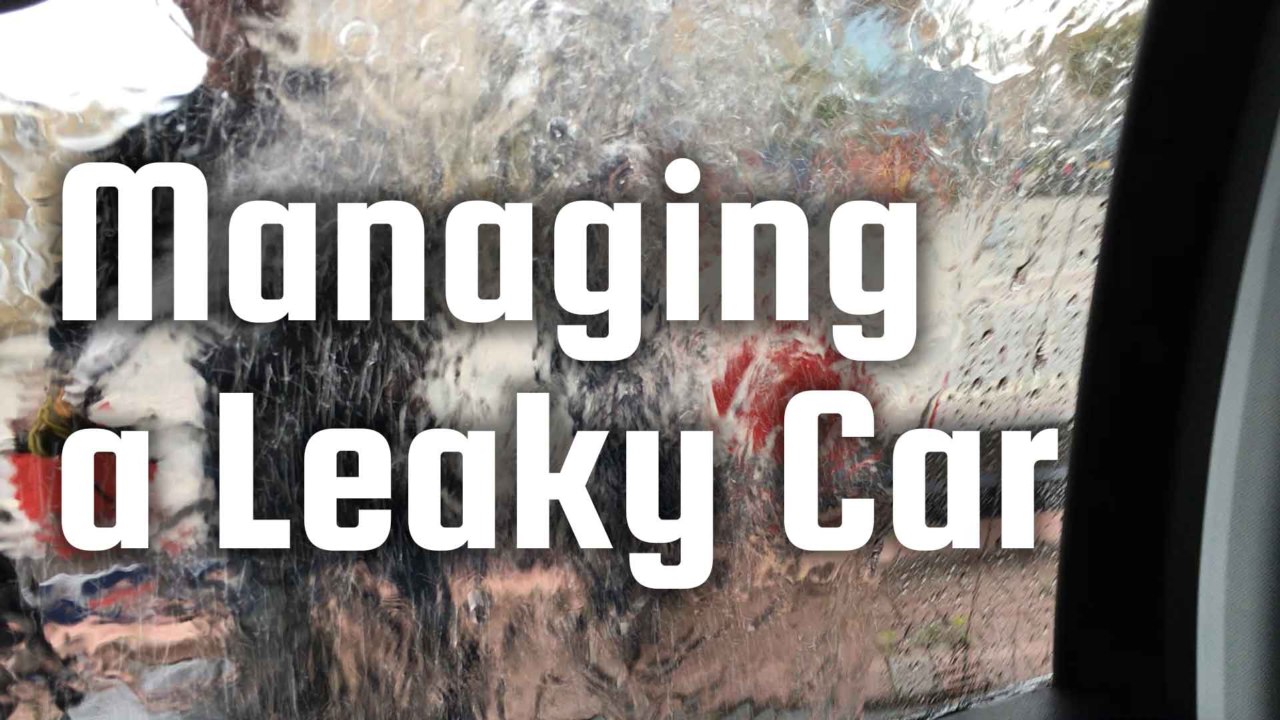
If you have a car with a rain water leak, but you can't get it repaired right away, you may need to manage the water ingress until you can get it fixed, or drier weather comes around.
It may be waiting to go to a garage which is booked up, maybe you can't afford to lose the car right now, you can't afford to do it right now. It may even be the case that the value of the car doesn't warrant the expense of the repair. There are many reasons that you may have to nurse a car with a water leak for a month or two. In this article, we will offer some advice to help you get through.
The Problems to overcome
You may have noticed that you have a water leak is that because your windows are constantly steamed up, you may have noticed your carpets are wet or there is water in the boot. These are annoyances in themselves, but they can lead to other issue with are far more critical.
Electrical issues
If you are seeing puddles of water on top of your carpets, be aware that your carpet underlay could be four inches deep. There may be a lot more water in your car than you might realize. The wiring looms run under your carpets and on most cars, this is also where the main CPU is. This is the central processing unit, the computer which controls your car. You will also find other computers such as the airbag control units and even your stereo equipment.
These units have some degree of waterproofing; however, they weren't designed to be submerged. It is also the case that if you do have condensation on your window, there will also be condensation on all metal surfaces such as electrical connectors.
So, you will need to keep an eye on your car's electrics. If you are getting warning lights on your dashboard or suddenly, your electric windows aren't working, the leak is likely the cause.
While you can nurse a leaky car along, we cannot recommend that you do this if you start seeing electrical issues. These could be dangerous, especially with hybrid and electric cars.
Mould

When you have moisture in a car, you will eventually get mould and mildew. This is not a problem you should take lightly. When you drive your car, you are sitting in a sealed metal box with the mould, which means you will be exposed to much higher concentrations of mould spores in the air than can possibly good for you.
You should be especially aware of this if you have asthma or are transporting old people or young children.
Thankfully, mould and mildew is something which you can manage with some cleaning and the right products.
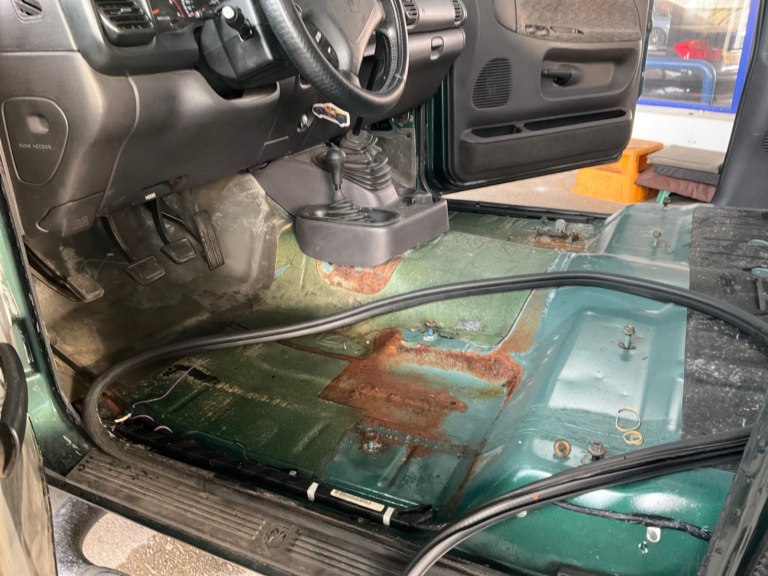
Rust and Corrosion
Corrosion is more of a long-term problem, so if you are nursing your car along for a few months until you can get it fixed, then you probably shouldn't have to worry too much. But let's say, for example, you have only just realized you have a leak, but have had issues with damp odours and steamed up windows for the last few years, it is possible that you have had puddles under your carpets for a long while. There are several safety issues which can arise from corrosion, but the main one is the bolts that hold your seat to the floor. It could also be the case that your seatbelt mounting points have been underwater. It might be worth a look if you are in doubt.
Managing a leaky car
Assuming you don't have any electrical issues and your seat hasn't rusted away from the floor, we suggest you first address the mould issue.
Anti-Fungal Products
This is actually very easy because there are no end of products you can introduce to your car which are anti-bacterial and anti-fungal. The main issue is finding one without an overpowering smell. If there is a big puddle of water under your carpets, pouring on some Dettol, Milton Fluid or Zoflora will make it an inhospitable environment for bacteria and mould, but your car will smell like a hospital. You might actually like that, but there are alternatives.
There are plenty of products you can use, many available from your local supermarket. There are special laundry detergents for washing nappies or especially formulated for washing sports clothing, which contain anti-fungals and antibacterials. Read the labels, you want one that doesn't contain bleach.
We suggest you make up a solution in a spray bottle and apply it generously to your carpets. You will tend to find mould anywhere where there is dirt that the mould can feed off. So, it will be on the dust and crumbs around the seat runners, on the boot where the dog sits, the crisps the kids lost down the back seat and anywhere where you have touched. The natural oils from your skin is enough for fungus to feed from, so it is commonly found on seat belts and seat edges. It does prefer shady areas, so look up and check the headlining because it's often found there too. Give it a spray and that should be enough to kill the spores which get into the air and are harmful if breathed in, in large quantities.
Use the car
If it will be several months before you can get the car fixed and dried, you might be tempted to park the car somewhere and use your second car instead. There is some merit to this idea, and we certainly recommend parking it undercover if you can, but using the car will get it warmed up, circulate the air and stop it going stale. It also does all the other stuff that is good for a car, rotates the tires, gets the oil circulating and nocks the rust off the brakes.
If you do decide to park the car, if you can do it undercover. Park it in a secure garage if possible, that way it will keep the rain off, and you can open up the windows, so it can air out. Then give it a run every week or two, drive it around the block until the engine warms up.
Do not use a car cover. They make the car dark, which mould loves, and they stop air circulating. There are air vents around your car which help it breathe, but covering your car with a cover covers the whole thing, trapping in stale moist air and preventing any evaporation you might have benefited from and causing additional condensation. It's a great way to grow mould.
Water finds the lowest point
It really isn't unusual for water to leak in at the back of the car, run through the box sections to the back seat, pour down to the rear footwell, then run to the front footwells. At this point, you assume that because you have a puddle in the front, the leak is at the front.
This is important information to know if you are going to try and find and fix the leaks yourself, but also handy to know if you are trying to manage a leak.
For example, if you park on a slope, it might affect where the water ends up, and you can use this to your advantage. Most of the really important electrical stuff is in the front of the car, so if you can park with the car's nose up, you might be able to keep much of the water near the back. Of course, if you then get in it and drive it without removing the water, it will still slop around all over the car, so it is best to try to remove the water.
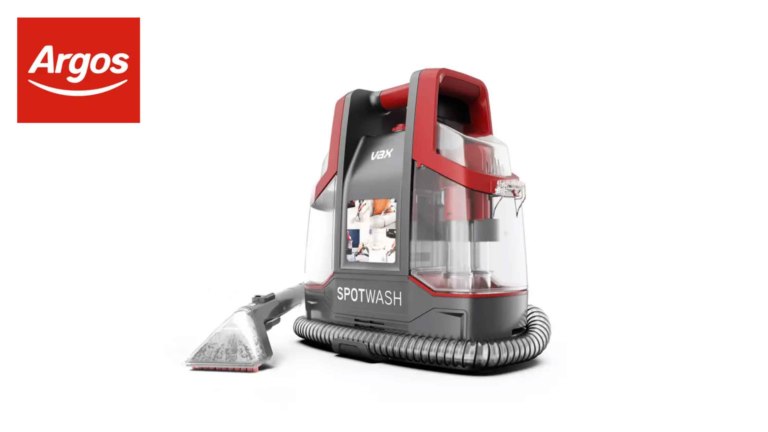
Extracting water
If you are seeing big puddles or your boot is full of water, then you can start with an extractor, otherwise known as a wet-vac or carpet shampoo machine. The chances are you don't have one, but if you do or know somebody who can lend you one, this is what we would recommend.
You may consider buying one. You can get a portable spot cleaner for £100-£150, or you can get a very decent Numatic Cleantec 370, or Karcher SE 4001 for as little as £250. Obviously, these things have other uses besides sucking water out of a wet car and might be well worth the investment.
The alternative is to use lots of bath towels, which we advise even if you do have a carpet extractor. They are highly absorbent and very effective, and if you have a bunch of them you can rotate them around. If you think that water is getting in at the back of the car and making its way to the front, you can place them at the point of ingress or somewhere along the route to head off the water.
Using a heater or dehumidifier
If your car has water in it, your car's heater is going to do little to dry the carpets or water under the carpets. So don't be tempted to put it on hot and point it at your feet. All you are doing is causing a bit of evaporation, which is making the air in the car moist, which will just steam up your windows more.
We have written a whole article on steamed up windows and what to do about it, but the bottom line is, you are best to set your heater pointed at the windows, turn off the 'circulate' feature, and put it on as warm as you can stand without cooking yourself.
If, however, you are keeping the car garaged, you may be able to an additional heater or dehumidifier in the car when you aren't using it. You will have to chose which is the best method for you, you could put it in the car, or next to the car with the doors/windows open. If you have a damp, draughty garage, this is going to be far less efficient. However, putting electric powered heaters in a wet car does carry some risks. I am sure we don't need to tell you that water and electricity don't mix, so you will need to be very careful how you set this up. You need to consider the cost of purchasing, of running, plus the risk of fire.
Mechanical dehumidifiers
Electric dehumidifiers are incredibly effective, if you happen to have a large one laying about, which you probably don't. If you can borrow one, that's great, but there is an alternative which is surprisingly effective.
This is unlikely to do much if you have puddles of water in your footwell or four inches of water in the spare wheel compartment, but your leak is leading to a bit of damp, then the dehumidifier pots you can buy from any supermarket are rather good. We know they are good because we have tried them because they actually fill with water.
At the time of writing, they cost £4 for four at Asda , and about five times that amount on Amazon and eBay. The problem with them is that they don't stand up very well and will fall over, leaking out all the water again. So, we recommend getting some electrical tape which is probably in the same isle, and taping a bunch of them together into a raft, and sliding it under your seat. You be able to fit 8-12 under each seat. So for £25 you could most likely pull a couple of gallons of water out of your car. Think about that, you could buy an electric dehumidifier for that sort of money which has a tray that only holds a cup full of water.
There is another trick which is not quite so efficient, but it works, and that is to use cat litter. It is designed to not only absorb moisture but also odours and so will pull water right out of the air. Not all cat litter is made equal, and so the expensive gel crystals may work more efficiently than baked clay or paper, but you pays your money and takes your choice. I have personally tested cheap cat litter and it works.
All you need to do is put a large bag of it in the boot of your car and open the top, every week or so you can give it a stir to bring the dry stuff to the top. You will want to make sure it won't fall over and spill it's contents everywhere, and you don't want it sitting in a puddle of water as that would also cause a soggy mess. But it's that simple, and you should notice that your car doesn't have so much condensation.
Bungs and holes
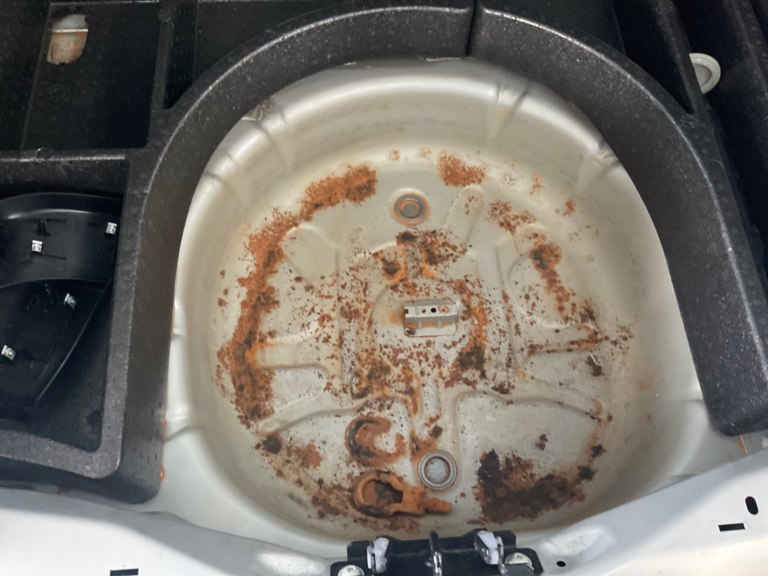
"Why not just let the water out by making your own drainage holes?"
We have seen this a few times, where people have drilled holes to let water out, punched holes through floor pans with a hammer and nails, or removed rubber or metal bungs. Unfortunately, this is sometimes what lets the water in, as water can spray up from the road and get in that way. Also, making holes where holes don't belong is inviting rust.
With that said, we don't rule it out completely. You may find that the boot has metal bungs which you could be removed to let out water. You would probably destroy the bung getting it out, but if you are coming to us for repairs, we could replace it with a new one, once your car's leaks are fixed.
If you have decided that your car's value isn't worth the cost of the repairs, and you just want to limp along with it until it gets sent to the knacker's yard, then maybe it's a solution with few downsides. Just be aware that you will want to make holes as far away from the tyres as possible, and maybe do something to prevent rust.

by Danny Argent
technical writer, education and training.
Related Blogs
Here are some more of our latest #CarWaterLeaks blogs
how to get rid of mildew smell in car
Musty, damp smells are distinctive and annoying, but can also be a health hazard. We will look at what causes mildew and how to get rid of musty smells.
Read ArticleWhy your car windows are steamed up in the morning & how to fix it
Mist, fog or condensation is annoying when you just want to get to work in the morning. So lets look at the causes and what we can do about it.
Read ArticleHow is water leaking into my car?
We have been finding and fixing leaks for many years now, and we keep seeing the same problems reoccurring. In this article we will share our top 10 car water leaks.
Read ArticleWhat to do if you find water in your car
If your car has mould in it, chances are there will be water in it. If the car has steamed up windows then possibly there is water under the carpet somewhere.
Read ArticleThe trouble with wet carpets and moisture
When you get in your car you don't expect the interior to be wet and have a damp smell. Sadly there are a number of issues that can cause this. Fortunately, our team can help. We are the most skilful business providing water leak detection Chelmsford ...
Read ArticleWhere is that water leak coming from?
New Again is the best provider of luxury car restoration Chelmsford has to offer. We have earned this reputation by assisting customers in a myriad of areas, including paint repair and pre-lease inspections.
Read Article
Can We Help You?
"We can offer specialist advice on the best car service to suit your requirements"
When bringing your car to New Again, we often ask you to explain exactly the reason for having your car Protected, Valeted or Repaired. Once we understand exactly what it is you are trying to achieve, we will appraise your vehicle using our detailed appraisal check-sheet allowing us to identify areas of concern and tailor specific services that match your requirements and budget.
If you are not sure what service you need and would like to speak to one of our technicians, simply request a callback by filling in the form on our contact page.
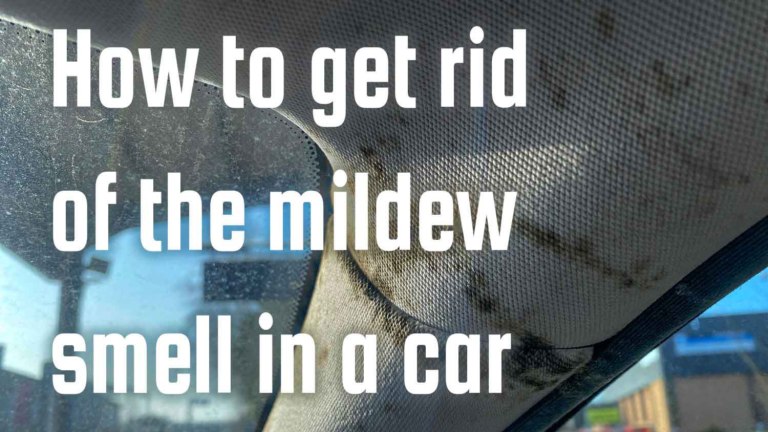


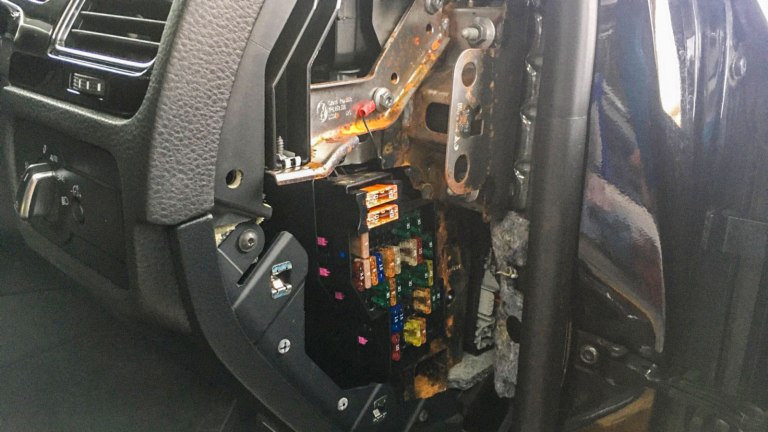
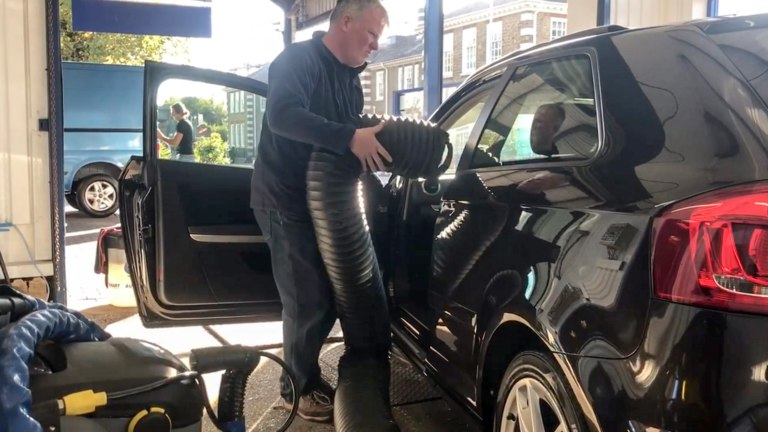

Share this blog